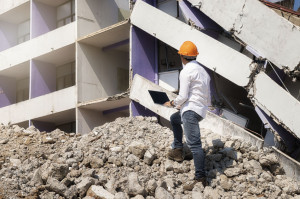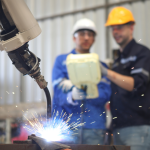 In Utah, although we know earthquakes are possible, we’re not used to thinking about earthquakes regularly. But in recent years, several have rattled our state. The most recent, a 4.5-magnitude earthquake that occurred this past July, struck Southern Utah. It was a reminder that Utah rests along the Wasatch and Hurricane Fault, which causes hundreds of minor quakes each year and has the potential to trigger a serious seismic event.
In Utah, although we know earthquakes are possible, we’re not used to thinking about earthquakes regularly. But in recent years, several have rattled our state. The most recent, a 4.5-magnitude earthquake that occurred this past July, struck Southern Utah. It was a reminder that Utah rests along the Wasatch and Hurricane Fault, which causes hundreds of minor quakes each year and has the potential to trigger a serious seismic event.
As civil engineers, we conduct structural analysis as part of our services. That service includes seismic analysis, which evaluates a building’s structural integrity and the potential impact seismic activity may have on it. In Utah and other regions, seismic analysis is becoming more necessary and is an integral part of a civil engineering team’s structural analysis.
What is seismic stability?
When conducting seismic analysis, our team looks at hundreds of factors, but they all fall into three primary factors determining a building’s integrity: determinacy, stability, and ductility. Let’s explore these three factors.
- Determinacy: One crucial factor for determining a building’s structural stability is calculating how it will respond to outside forces. Engineers must classify structures as either statically determinate or statically indeterminate. A determinate structure can be analyzed using the three fundamental equilibrium equations (sum of horizontal forces, vertical forces and moments). However, indeterminate structures have additional components that require more analysis and equations to determine how they will react to outside forces. Typically, this makes these structures more resilient to seismic events.
- Stability: A building’s stability is how it will maintain its configuration during seismic activity and resist outside movement by not collapsing or breaking apart.
- Ductility: This is the building’s ability to absorb energy while gradually failing. This factor, sometimes called the ‘secret sauce of seismic engineering,’ is crucial for structures that need significant seismic stability. Buildings with high ductility can slow down the collapse process during an earthquake and give occupants time to evacuate.
Part of our structural analysis process involves examining these factors in a building or site. Based on these principles and others, we evaluate how the system can withstand outside forces and make recommendations to improve the building’s stability in the event of seismic activity. One recommendation is to implement new designs to improve stability or utilize materials that improve a building’s seismic stability.
What materials improve seismic stability?
- Flexible Connections and Base Isolation: Structures designed with flexible joints and connections can sway with ground motion, which reduces the overall stress on the building. A typical example is base isolation, where bearings or sliders are installed between the building and its foundation to reduce the transmission of seismic waves. Base isolation can dramatically reduce structural stress during an earthquake by allowing the building to move independently from ground vibrations. During a retrofit of the Utah Capitol building from 2004-2008, 265 base isolators were installed under the building as part of a $273 million renovation. The Capitol building can now sway two feet in any direction during seismic activity and absorb the force.
- Moment-Resisting Frames and Shear Walls: Moment-resisting frames withstand bending forces, allowing structures to flex while remaining stable. On the other hand, shear walls resist lateral forces and prevent buildings from shifting excessively. Combining these features helps distribute seismic forces across the structure, reducing the likelihood of a building collapse.
- Redundant Systems: These systems are more resilient during seismic activity because they offer alternative load paths if one component fails. For example, a structure with multiple beams and columns can distribute forces more effectively across the building and prevent collapse.
Project spotlight: Cable Mountain Lodge
We’ve worked on many projects where we have provided structural and seismic analysis. One project that was a great experience for our team was the Cable Mountain Lodge in 2006. Our team provided structural and seismic analysis services for multiple two-story hotel buildings. The goal of this project was to have the buildings meet seismic design category D. This category is the second highest category and structures that meet this code must meet strict structural requirements for framing systems, bracing, and reinforced connection to absorb seismic energy. To meet this requirement, we incorporated a prefabricated truss roof system with a web I-joist floor system into the design. This feature supports the gravity load and absorbs movement. It was a challenging project, but we learned a lot, and it turned out beautifully.
Consider seismic activity in your design plans
Seismic activity, even in our home state of Utah, cannot be ignored. It’s essential to plan for these events and implement stabilizing features into a structure’s design. If you’re planning a new building or construction project, our team can provide structural and seismic analysis. Reach out today for a consultation!








